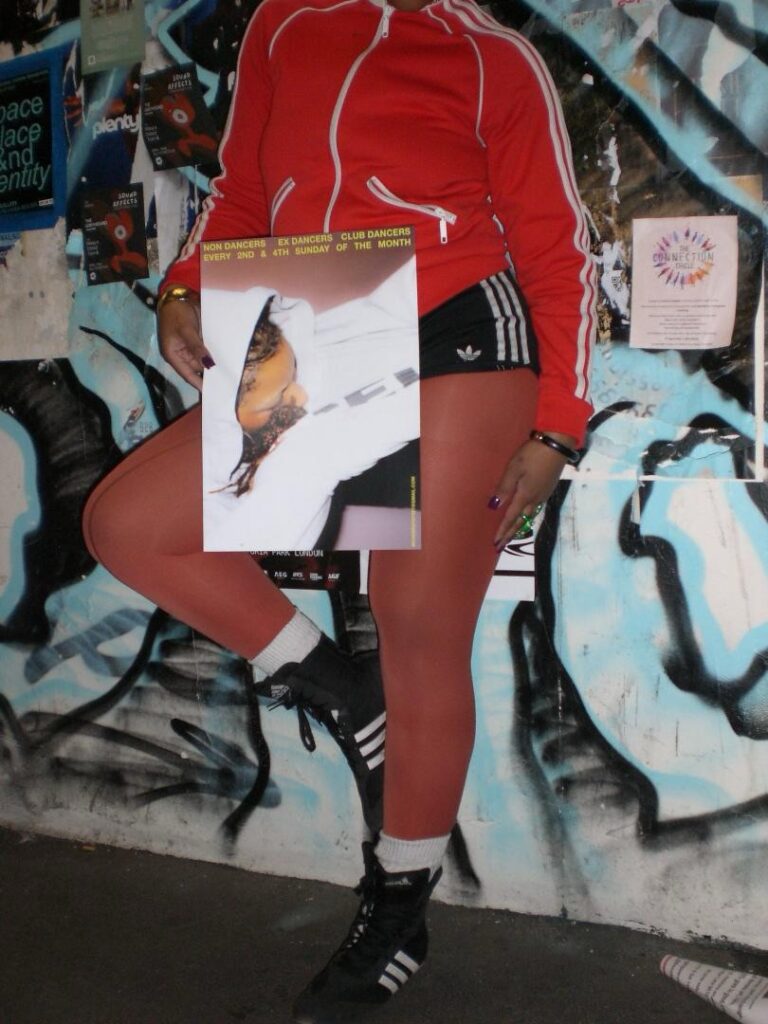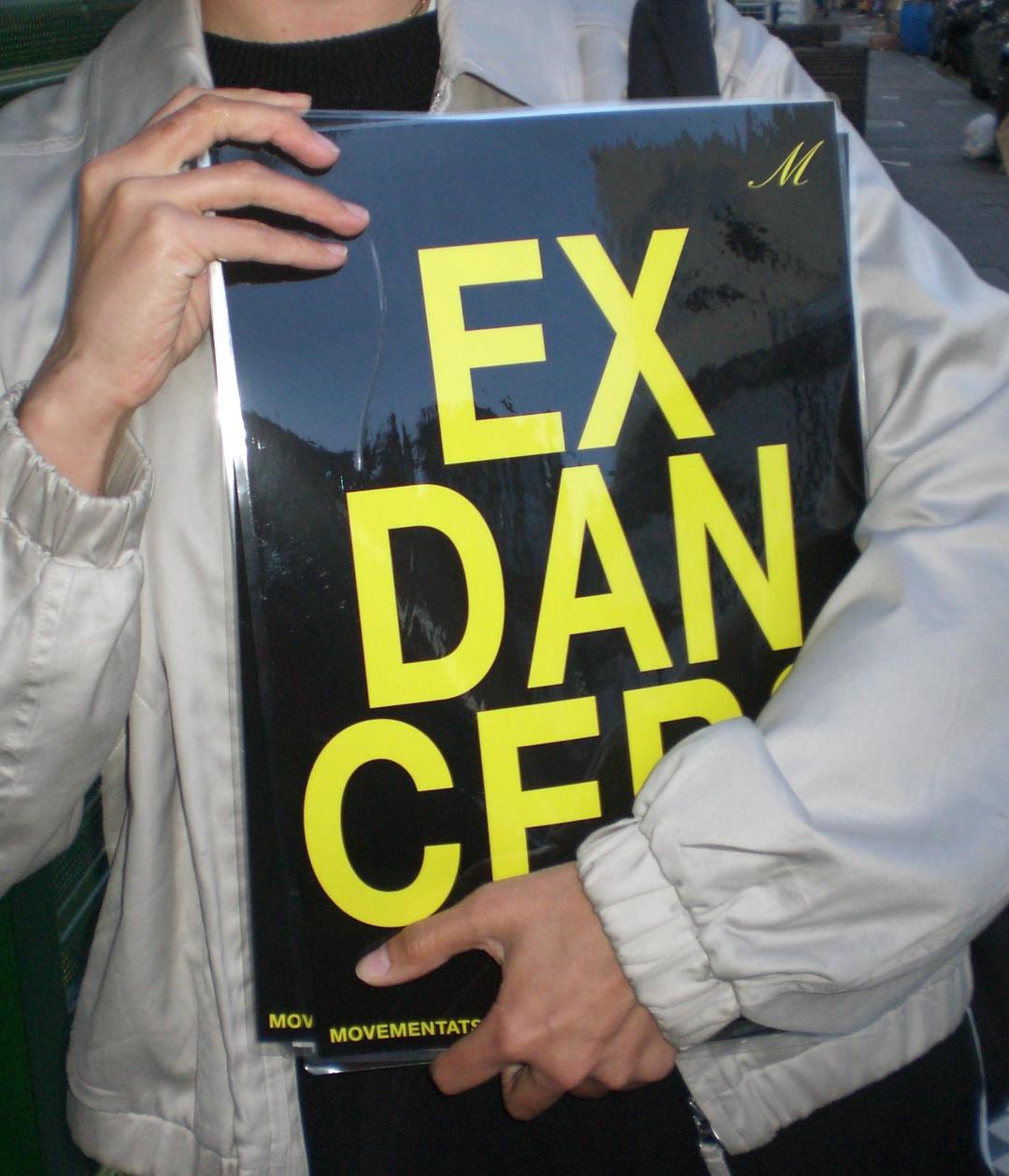Words by Stella Rousham.
Mya and Flo apologise for the background noise – the soft din of a South London pub is faintly audible as they huddle side-by-side on my Zoom screen. Combining their divergent artistic practices with a shared love for dancing and community, we chat about the launch of their bi-weekly movement classes at Set Social – a multi-arts space in Peckham. Bringing club culture to sober, Sunday afternoons, Movement at Set welcomes dancers and non-dancers alike into a collective euphoria of music and movement. Reclaiming movement as joy and resistance, we discussed the line between discomfort and growth in dance classes, the vulnerability of improvising without music and why the English are so distinctly afraid of public dancing.
Stella: Would you like to both introduce your practices and backgrounds as artists?
Mya: I work across fields – exhibitions, art-making, a bit of production and advertising. I like a mixed bag. Movement is newer to me, but it’s a central through line, as well as thinking about people and spaces of community. I’m interested in looking at movement and dance through anthropological lens. A lot of my work looks at what it means to be a dancer, as someone who’s not a trained dancer.
Flo: I have struggled with identifying as an artist or dancer. Even though I grew up in dance and quite formally trained – at the Centre for Advanced Training scheme in Ipswich and The Place – I never felt good enough and dealt with a lot of imposter syndrome.
I have been enjoying using the term ‘ex-dancer’ – both for myself and in our classes. I’ve found it very empowering; it’s lifted a lot of pressure, allowed me to detach from my previous dance training, whilst giving me freedom in movement spaces.
Stella: Could you go into a bit more detail about your relationships with dance or movement?
Flo: After graduating, I took a long separation from dance. When I came back to it, community and improvisation were at the forefront. It was a real priority for me to work with people who are non-dancers – like Mya. I’m really grateful for this collaboration; I find that artists without formal dance training understand movement in completely different ways to me. I’m still trying to untrain how I think about movement.
Mya: I danced a bit when I was in kid, my mum put me in a ballet class, but I never really committed and just stopped doing it. When I moved to London, three/four years ago now, I realised that I like to party. If I’m on a dance floor and the music is good, I will be busting some variety of a move. Going out was my way of getting back into dance and realising there is a place for dance in my life.
I didn’t start thinking about dance in a more serious way until I started going to movement classes at Set Social in my last year of uni. That’s when I started exploring the background and historical context of dance and music. Ballet for Non-Dancers – a project I launched with a friend Edith – emerged around that time. At first it was a movement practice, but now it’s more of a world building project. We look at bringing different people into the space of ballet as a point of subversion. Ballet is so specific about what kind and colour of bodies it lets in. We’re interested in how ballet shows up in everyday life. What my ballet is versus someone else, like a bus driver or a nurse. These jobs require their own formal training and movement practices which are valid in our eyes.

Stella: The idea of a bus driver or nurse existing through their own kind of ballet is really beautiful. If you take away the exclusionary parts of ballet, there is an essence that works for everyone.
Mya you mentioned a background in Anthropology, I’m interested in how this informs your movement practice?
Mya: I don’t technically have a background in Anthropology, but I do like to make up words to describe my practice. I approach movement as a Dance-thropologist. I’m interested in looking at the deeper social contracts that underpin dance and pop culture, particularly Black American culture.
I recently made a video, part of a larger body of work called Dancing America. It looks the appropriation of Black American culture through dance and music. This appropriation has been happening across history – like George Balanchine not crediting the influence of Black American dancer, Kathy Dunham. Dancing America looks at the shift during the 2020 pandemic when a lot of white Tik-Tokers were going viral for dances like The Renegade, without giving credit to the young, often black, women who made them.
Stella: You mentioned earlier that your movement practices draw on a lot of improvisation. What else can people expect from Movement at Set classes and your intentions behind them?
Flo: I find it quite hard to describe or give an essence of what the classes could be, because they are all different from each other. When it started, it was mainly improv. Whoever leads brings their own practice.
Mya: It really depends on who is leading the class. My favourite workshops have been when we’ve brought in someone to focus on sound.
Flo: Music is a really huge part of it. I originally started Movement at Set with a friend of mine, Isabella Pinto. What we felt was missing from Gaga or other improv classes was the music wasn’t stimulating enough for us. If an artist isn’t there, we ask the teacher to really take time to create a playlist.
Stella: When you say artists, do you have live musicians?
Flo: Live DJs. They’ll bring their decks and plug it into the system. We’ve yet to have a live musician, which I’ve always wanted, it would be so cool.
Stella: It’s interesting what you say about the music, because I think it can make movement more accessible for non-dancers.
Flo: Music brings rhythm and allows people to connect movement to something recognisable. Our classes have an almost sing-along feel to them. The music instantly makes the classes feel more light-hearted. When I was at dance school, I went out a lot. It wasn’t frowned upon, but I found there was a gap between going out and dance school, whereas for me, it felt so connected. That’s what I love about Movement at Set – it’s a combination of all those things. We advertise the classes to club dancers and non-dancers. I haven’t found an opportunity in London where you can enjoy dancing with that club energy, but on a Sunday afternoon when you’re sober.
Stella: Mya, what was your experience attending moment classes as a non-dancer? What made you feel more comfortable in that space or drew you to it?
Mya: The first few times I took class was quite uncomfortable, particularly as we were using deep, intense imagery. It felt extremely new for me, but I also felt very watched. Something I’m constantly telling people at Ballet for Non-Dancers or Movement at Set, is that improv is not going to work every time. I will have classes where I have to sit down; you can’t always get to that state of movement flow and awareness.
Flo: It’s so funny to hear you talk about your first experiences with improv, because I really over-analyse and overthink how to make people feel comfortable when they come to Movement at Set. Sometimes I’ll do a talk it at the beginning of a session and say “move like nobody’s watching you” or “close your eyes”. I’ve been in a lot of dance spaces where I haven’t felt comfortable. It’s important for it to feel welcoming, but sometimes you can’t control it.
Stella: There’s certain degrees of discomfort. There’s a fine line between what discomfort people can grow from and what is actually debilitating.
Mya: I always try to emphasise in the classes that you don’t have to like all of it. We had a class yesterday and JJ (one of the guest artists) said “I’m going to present you with some offerings”. I thought that was such a beautiful way to put it – a gentle suggestion that might resonate with you, and if it doesn’t, that’s fine.
In a 2025 context, there is a lot of catering to make sure everyone is comfortable. But it’s also ok to be pushed out of your social boundaries – obviously to a degree and making sure everyone is treated with respect, dignity and integrity. Vulnerability is intrinsic to improv so you have to be able to confront that part of the space.
Stella: Did you have much experience with dance in Chicago? How does this compare to London?
Mya: My relationship to dance in Chicago was quite different. I was younger when I was living there – 18/19 – and it was right after the pandemic, so I wasn’t really going out.
From what I’ve seen and heard, there is massive respect for house dance and music in Chicago. Here, in London, I feel like I don’t really see people dance. I’m curious about why people in London are so afraid of dancing. Whereas growing up, there was more of a social justice-oriented approach to movement – moving for enjoyment, self-pleasure and resistance.
Stella: People in England are definitely restrained, even in social settings. It’s only when they have a bit of alcohol that they can dance. Then when people do dance, it’s almost satirical, like at a wedding, dancing badly on purpose.
Flo: We went out to two clubs on Saturday night and at both we were like, “Where is the vibe?”. We were at the front but nobody else was dancing. There used to be a club called Total Refreshment Centre in Dalston. It was a very cool, underground venue with different live artists and musicians who would get people of all ages, really dancing, without clinging to social groups. It was the first time I’d ever seen something like that in London. I was quite upset to find out that it had closed down; it was only open for nine years.
Mya: There’s so many barriers to entering and finding spaces like that. For that reason, it’s important that our classes at Set are not too expensive.
Flo: It was never our intention to make money off it. Any money we get, we pretty much give it to the teachers.
Stella: Movement at Set is obviously based in Peckham. Have you thought about working in different spaces? Do you have plans for where the project could go in the future?
Flo: Coming from a culture in dance where people always ask: “What’s next?”, I actually feel very content at Set. At the moment, we’re both quite busy, so once every two weeks is the perfect amount for us. Set is a super DIY, random space that’s so messy and earthy. Our vibe really matches that environment and I don’t know if we could find it anywhere else.
Mya: For me it would be about exploring our classes in a completely different setting, like a festival. That would completely change the dynamic.
Flo: It would be nice for our classes to reach a further community. We do usually attract people through Instagram; I love it when more of a range of people come.
Movement at Set classes run on the 2nd and 4th Sunday of every month. Tickets available online through the link below from £7 – £12.
Movement at Set Tickets: https://setspace.uk/series/movement-class/
